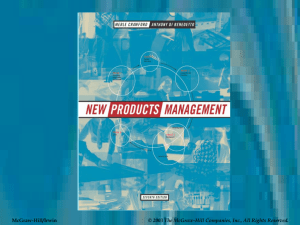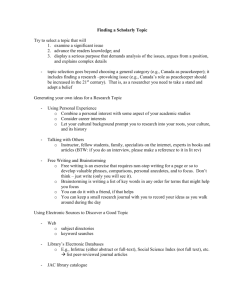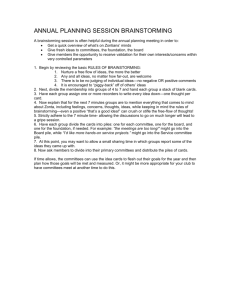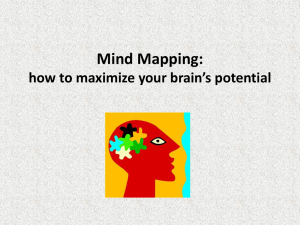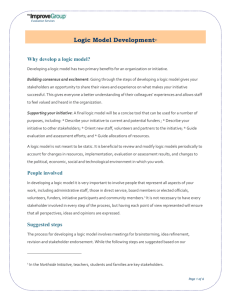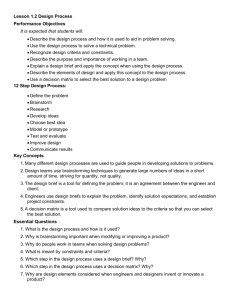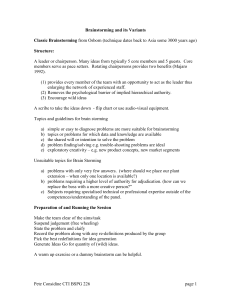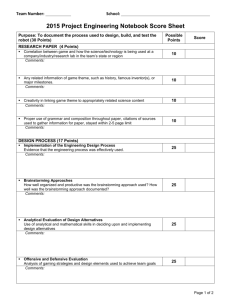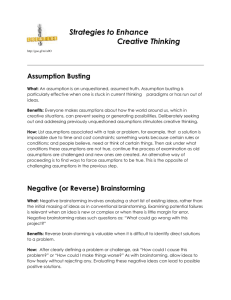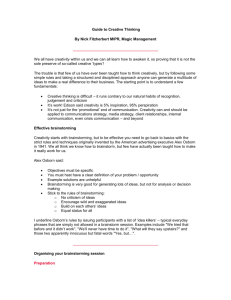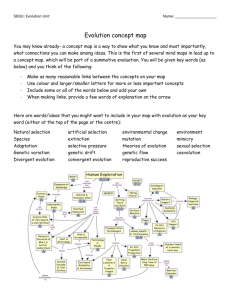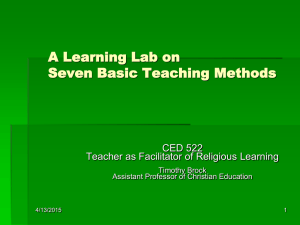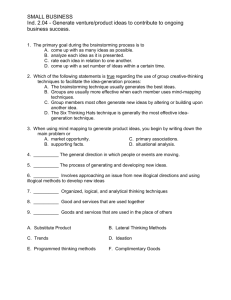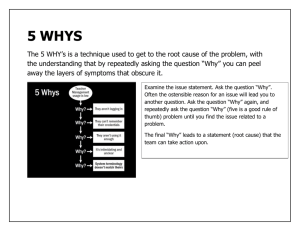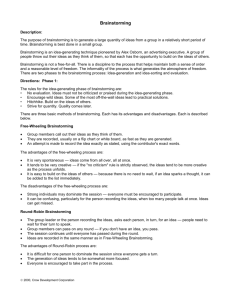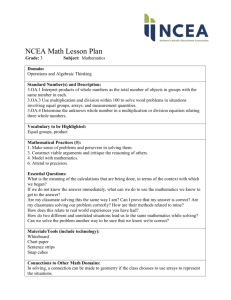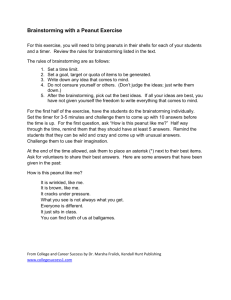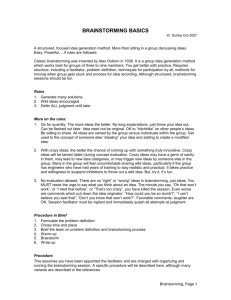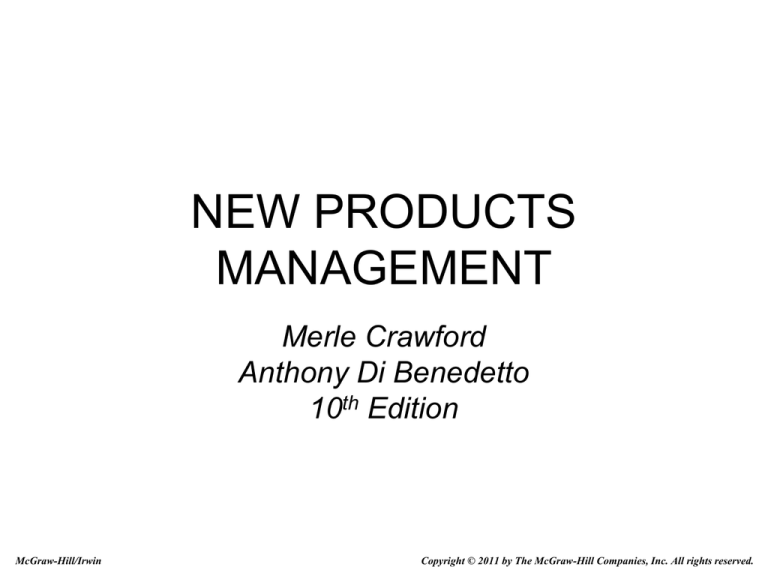
NEW PRODUCTS
MANAGEMENT
Merle Crawford
Anthony Di Benedetto
10th Edition
McGraw-Hill/Irwin
Copyright © 2011 by The McGraw-Hill Companies, Inc. All rights reserved.
Chapter 05
Finding and Solving Customers’ Problems
5-2
Problem-Based Concept Generation
5-3
Problem Analysis: General Procedure
1. Determine product or activity category
for study.
2. Identify heavy users.
3. Gather set of problems associated
with product category.
– Avoid “omniscient proximity” — rate
importance of benefits and levels of
satisfaction.
4. Sort and rank the problems according
to severity or importance.
5-4
Problem Analysis Applied to the Cell
Phone
• Keeping the unit clean.
•
• Breaks when I drop it.
•
• Battery doesn’t stay
charged long enough.
•
• Finding it in dark.
•
• Battery dies in mid•
conversation.
•
• Who “out there” hears me?
• Dropped calls.
•
• Looking up numbers.
•
• Voice fades in and out.
•
• Hard to hold.
Health risks?
Can’t cradle between
ear and shoulder.
Antenna breaks off.
Flip cover breaks off.
Disruptive instrument.
Can’t see facial/body
language.
Rings too loud/too soft.
Wrong numbers.
Fear of what ringing
might be for.
5-5
The Bothersomeness Technique of
Scoring Problems
List of pet owners' problem s:
N eed constant feeding
Get fleas
S hed hairs
M ake noise
Have unw anted babies
A
P roblem O ccurs
F requently
98%
78
70
66
44
B
P roblem is
B othersome
21%
53
46
25
48
AxB
.21
.41
.32
.17
.21
5-6
Problem Analysis: Sources and
Methodologies
• Experts
• Published Sources
• Contacts with Your Business Customers
or Consumers
– Interviewing
– Focus groups
– Observation of product in use
– Role playing
5-7
Example of Problem Analysis:
Dyson’s Air Multiplier Fan
• Conventional fan problems:
– Spinning blades chop airflow
– Hard to clean
– Blades can be dangerous to children
– Fan tips over
– Energy inefficient
• Air Multiplier: bladeless (uses technology adapted from
hand dryers), and attractively designed.
– Airstream is smooth and danger is eliminated
– Low center of gravity eliminates tipping
– Much more effective and efficient cooling
– No blades to clean
5-8
Typical Questions for Problem
Analysis Focus Groups
• What is the real problem here – what if the
product category did not exist?
• What are current attitudes and behaviors of
focus group members toward the product
category?
• What product attributes and benefits do the
focus group members want?
• What are their dissatisfactions, problems, and
unfilled needs?
• What changes occurring in their lifestyles are
relevant to the product category?
5-9
Observation and Role Playing in
Problem Analysis
• Carmakers send their designers out to parking
lots to watch people and how they interact with
their cars (Ford called this “gorilla research”).
• Honda got insights as to how large the
passenger compartments of their SUVs should
be by observing U.S. families.
• Bausch and Lomb generated ideas on making
contact lenses more comfortable by getting pairs
of executives to act out skits in which they
played the eyeball and the contact lens.
5-10
Problem Analysis in Action
• Toyota pickups were perceived as too small for
North American tastes. Redesigned with a V8
engine and a much roomier passenger
compartment.
• Domino’s Pizza, for years known for average
quality but fast delivery, found that taste was
frequently mentioned as a problem in focus
groups. Intense product development led to a
better pizza which is Domino’s new competitive
position.
5-11
Scenario Analysis
• “Extending” vs. “leaping”
• Using seed trends for an “extend“ scenario
• Techniques:
– Follow “trend people”/”trend areas”
– “Hot products”
– Prediction of technological changeover
– Cross-impact analysis
5-12
Relevance Tree Form of Dynamic
Leap Scenario
5-13
Wild Card Events and
Their Consequences
• No-Carbon Policy: Global warming may cause governments
to put high taxes on fossil fuels, shifting demand to alternative
sources of energy. This changes the allocation of R&D
investment toward alternative energy, possibly causes new
“energy-rich” nations to emerge, and ultimately may lead to a
cleaner environment for everyone.
• Altruism Outbreak: This is the “random acts of kindness”
movement – solve social problems rather than leaving it up to
the government. Schools and other institutions will revive due
to community actions, and perhaps inner cities would be
revitalized.
• Cold Fusion: If a developing country perfects free energy, it
becomes prosperous overnight. It gains further advantages by
becoming an energy exporter.
5-14
Solving the Problem
• Group Creativity Methods/Brainstorming
• Principles of Brainstorming:
– Deferral of Judgment
– Quantity Breeds Quality
• Rules for a Brainstorming Session:
– No criticism allowed.
– Freewheeling -- the wilder the better.
– Nothing should slow the session down.
– Combination and improvement of ideas.
5-15
Brainstorming Techniques
•
•
•
•
•
Brainstorming circle
Reverse brainstorming
Tear-down
Phillips 66 groups (buzz groups)
Delphi method
5-16
Electronic Brainstorming
• Supported by GSS (group support systems) software.
• Overcomes many drawbacks of brainstorming (only one
can talk at a time, fear of contributing, “social loafing”).
• Participants sit at networked terminals.
• Contributions are projected on screen, and also recorded
(so no errors are made in transcription).
• Can be done over multiple sites via computer linkups or
videoconferencing.
• Can handle larger size groups (into the hundreds).
5-17
Online Communities
• Any group that interacts using online social networking
or a similar medium.
– Open online communities (Facebook)
– Lead user communities
(http://www.tivocommunity.com)
– Firm-organized communities (J&J’s
http://www.babycenter.com)
– Private online communities set up by service
providers like MarketTools (under 500 members)
– Proprietary online communities (thousands of
members that statistically represent a target market)
5-18
Use of Online Communities
• Listen to the voice of the customer
• Monitor public communities and blogs to
spot new trends and opportunities
• Establish rapport with customers and
enable customer support
• Build emotional bonds with the customer
5-19
Online Community in Action:
Del Monte Pet Food Division
• Working with MarketTools, analyzed data from millions
of blogs, forums, and message boards,
• Identified biggest concerns of pet owners.
• Identified new customer segment (“Dogs Are People,
Too”)
• Created invitation-only online community to encourage
customer innovation (500 consumers)
• Community generated and refined ideas for new
breakfast product.
• New product, Sausage Breakfast Bites, launched in half
the normal time.
5-20
Drawbacks to Online
Communities
• They are hard work
• Costly and time consuming (hire
moderators and facilitators)
• Takes time for the community to mature
• Organizing the content so it is easy for the
members to find
• Member privacy, confidentiality, content
ownership, and other legal issues
5-21


